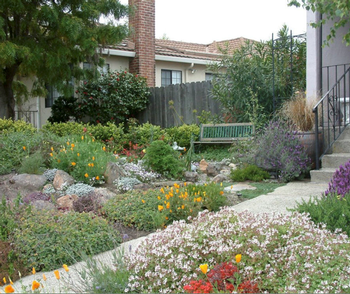Landscape with space
-
Fay Mark
-
Big spaces make playing hopscotch difficult for flames.
 CA native plants are well adapted to our drought-oriented climate and a preferred choice for fire-smart gardens. Credit: Gardensoft
CA native plants are well adapted to our drought-oriented climate and a preferred choice for fire-smart gardens. Credit: GardensoftWhen playing hopscotch, we learned that making big jumps is hard. In a fire-smart landscape we want to make it hard for fire to play hopscotch in our yards. Maintaining the proper space between plants is how we make it difficult for fire to hopscotch through your property to your home or your neighbor’s home.
Plant spacing is one of many planning and maintenance best practices for both a healthy garden, and a fire-smart garden. Plants that have to compete with their neighbors for soil nutrients and sunlight are not going to be as healthy as those that receive all the nutrients they need. Proper spacing also ensures their roots will not have to compete for nutrients and water.
But there can be too much of a good thing. Some plants require a certain number of neighbors to pollinate, so make sure that you don't end up with too few plants. Shade from properly spaced plants can crowd out weeds as they grow and keep the soil moist, creating a beneficial environment in your garden.
In a fire-smart yard, the zero to five-foot zone around the perimeter of structures on your property is the most important part of an effective defensible space strategy. Minimizing combustible materials and vegetation in this zone will reduce the potential for direct flame contact and elevated radiant heat exposure that would result from ember-ignited vegetation near your home or other structures on your property. Keeping plants around the perimeter properly spaced will prevent continuity of flames. Also, separate plants with noncombustible, permeable mulch like compost, gravels, or rocks of varying sizes.
In the five to 30-foot zone the goal is to reduce the connectivity between garden beds, shrubs, and trees so that if something ignites in this zone the fire will not be able to hopscotch to the house or into the crowns of trees. Prune and thin plants to reduce fuel densities and create more space between them. Creating separation between the plantings, trees, and the home achieves fuel and vegetation discontinuity. The jumps are too big for flames. Prune taller vegetation to control flame heights because fire likes to play three-dimensional hopscotch.
A home located on a steeper slope, in a windy area, or an area surrounded by unusually dense, tall, or combustible vegetation increases the intensity of fire behavior, making it easier for fire to hopscotch. Make the spaces bigger to slow the spread of flames.
If you remove dead trees and shrubs to create more space, leave the roots in place to help prevent erosion. If you replace plants, there are many tempting plant choices at garden centers. Be sure to research the mature height and width of plants before you make your selections. Reading the plant tag, and paying close attention to the light requirement, water needs, and mature size will help inform the spacing of your new plants. Then locate your new plants so they will be properly spaced when they mature in three to four years. Non-combustible mulch or low growing groundcovers can be used to fill in between the new plantings and conserve moisture while denying fire a path to your home when the new plantings mature.
A healthy and fire-smart landscape is the result of applying best gardening practices to your yard. Having a healthy landscape discourages pests on a long-term basis and will significantly reduce the need for pesticides which often have a negative impact on our environment. And proper plant spacing makes sure your yard won’t be a playground for fire.

